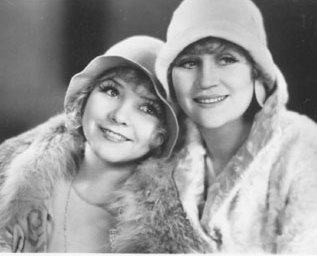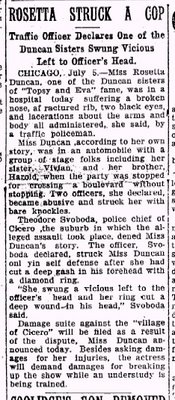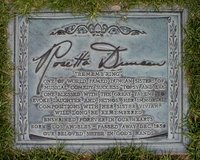 Christmas Day marks the three month anniversary of "Vitaphone Varieties," and I'd like to take a moment to especially thank all of it's readers and many supporters, who have been an incredible source of encouragement and inspiration for the author of these pages.
Christmas Day marks the three month anniversary of "Vitaphone Varieties," and I'd like to take a moment to especially thank all of it's readers and many supporters, who have been an incredible source of encouragement and inspiration for the author of these pages.Equal thanks, however, must go to the films, performers, music and recordings explored in these pages --- all which have proven, beyond my wildest expectations, that they still possess the power to intrigue, enlighten and entertain. This, at a time when it seemed they'd been all but forgotten and that all there was to learn about them had already been written.
The early Talkies, while resigned to forever lurk in the deep shadows behind the era of the silent film and the product of the 1930's, are still very much with us --- a bit forlorn and tattered perhaps, but patiently waiting to spring to life once again, whenever given the chance to do so.
The ultimate credit, then, must go to you --- the readers of this work, for allowing these distant voices and lost chords of another day, time and place to be heard and appreciated again... and anew.
For this holiday offering, and until "Vitaphone Varieties" returns on New Year's Day of 2007, a diverse selection of what I hope will be audible cheer!

From 1932, a two-sided British 78rpm recording entitled "Gracie's Christmas Party," in which the beloved British entertainer, Gracie Fields, welcomes listeners into her home on Christmas Eve for an evocative bit of melody and mirth. Gracie's rendition of "Singing in the Bathtub," from "The Show of Shows" (WB-1929) is but one of many pleasures to be found in this lovely artifact of a more innocent time, lost beyond recall.
"Gracie's Christmas Party" (1932)

While the allure of child performer Davey Lee is difficult to appreciate today, there's no denying his place in film history as the first true child star of the sound era.
Between 1928 and 1930, Lee appeared with Al Jolson in "The Singing Fool" and "Say It With Songs," and as a supporting player in "Frozen River," "Skin Deep and "The Squealer," but in 1929 would be given his own starring vehicle "Sonny Boy." As could be expected, Lee's popularity was as tremendous as it was ultimately short lived. Before a momentarily charmed public turned its attention elsewhere, the boy was utilized for advertising campaigns, public service announcements, all manner of film cross promotional advertising, and was the feature character in a number of children's books and at least one commercial 78rpm recording.

 For Christmas of 1929, the Brunswick two-sided recording of "Sonny Boy's Bear Story" was deemed an appropriate gift item for the kiddies, but as to how often they were allowed to listen to the recording on the family's phonograph is very much a matter of debate and tolerance, as you'll discover here.
For Christmas of 1929, the Brunswick two-sided recording of "Sonny Boy's Bear Story" was deemed an appropriate gift item for the kiddies, but as to how often they were allowed to listen to the recording on the family's phonograph is very much a matter of debate and tolerance, as you'll discover here."Sonny Boy's Bear Story" (1929) Davey Lee
Rather astonishing, but former child actor Davey Lee has his own small but charming web site --- surely the only such instance for any Vitaphone era performer, and well worth a visit. The link: "Sonny Boy Lives Here"
From 1931, an example of an idea that came either too late or too early in the game to be effective! Although Victor's first entry into the realm of the long-playing record was met with critical acclaim, it wasn't enough to lure the financially conscious public into the phonograph dealer's showroom. Had the device arrived four or even three years earlier, the outcome might have been rather different --- but as it was, 1931 wasn't the right time for entertainment luxury items. While the content of this demonstration disc (one side of which is offered here) is technically acceptable and certainly entertaining, it's interesting to note that most of the selections hearken back to an earlier day --- 1928, 1929 and 1930 specifically, and that despite the selling point being that this new process allows for greater "elbow room" for the performers, all that listeners heard here were, primarily, much abbreviated renditions of selections that could be heard, in full, on standard 78rpm recordings! A noble misfire.

With Frank Crumit as the Master of Ceremonies and performances by The Revelers, pianists Arden & Ohman and Nathaniel Shilkret leading the Victor Orchestra, here's a "right idea, wrong time" bit of phonograph history.
"Victor Artist's Party" (1931) Nothing about the history of the early talking films is set in stone, and the fact that much of it seems to be badly in need of reevaluation is made apparent by the wealth of misinformation surrounding the 1928 film "My Man," which featured multi-talented entertainer Fannie Brice.
Nothing about the history of the early talking films is set in stone, and the fact that much of it seems to be badly in need of reevaluation is made apparent by the wealth of misinformation surrounding the 1928 film "My Man," which featured multi-talented entertainer Fannie Brice.
Usually cited as being largely silent with a few interpolated vocalizations (as in "The Jazz Singer") and that the film performed miserably outside of key cities that could boast audiences appropriately ethnic enough to patronize and appreciate the film, such wasn't the case.
Whether or not readers of a Lima, Ohio newspaper entered the puzzle contest to the right in order to win tickets to see "My Man" is unknown, but audiences turned out in droves nonetheless --- and not only in New York, Chicago and Los Angeles, but in small cities and even smaller cinemas throughout the States, from late 1928 to mid 1929. Period reviews of the film are limited (many "reviews" are actually prefabricated publicity placements, but these become easy to detect in time!) but almost without exception, are tremendously positive. In fact, when a negative aspect concerning the film does appear, it's invariably in connection with the fact that the film does have brief periods of silence (a musical score with inter-titles --- perhaps 20% of the film's length) and that it wasn't designed as a full talkie.
 Indeed, in more than one instance, the film was "held over" for the run of another full week --- a fact in direct contrast with the usually gloomy evaluations of the film one encounters in some books.
Indeed, in more than one instance, the film was "held over" for the run of another full week --- a fact in direct contrast with the usually gloomy evaluations of the film one encounters in some books.
To be fair, the fact that precious little was thought to survive of the film for decades likely played a role in it's misrepresentation, but as bits and pieces of the film's Vitaphone disc soundtrack begin to emerge (only about 20% is still absent today) and fact gradually replaces opinion, the story changes.
Unfortunately, there's no getting around the fact that absolutely nothing is known to exist of the visual elements for "My Man," but hope springs eternal --- and films have a remarkable knack for turning up when least expected and from the most unexpected of sources too. I for one can't believe that a film so infused with the spirit and vibrancy of this most remarkable of all American entertainers would allow itself to remain lost forever --- if only for the fact that Brice herself would likely want nothing more than to set the record straight, once and for all.
 Two excerpts from the surviving Vitaphone disc material for "My Man."
Two excerpts from the surviving Vitaphone disc material for "My Man."
The first, a rendition of "I'd Rather Be Blue Over You," that begins simply at a piano as Brice puts her affection for an oblivious bloke (Guinn Williams) into song, and then opens up with full yet fleeting orchestra accompaniment.
"I'd Rather Be Blue..." (1928) Vitaphone Excerpt
The second, occurring on Fannie's wedding day, begins with an orchestral reprise of the above tune (one of the film's few silent sequences) and then explodes into an unusual and delightfully joyous rendition of the usually tear-laden song "My Man."
 To close this holiday edition of "Vitaphone Varieties," which will return on New Year's Day of 2007, a moment of subdued romanticism from a film not usually thought of in either term --- "The Gold Diggers of Broadway" (WB-1929,) in which Nick Lucas provides the vocal incentive for William Bakewell to tuck a reluctant Helen Foster into bed and then, gentleman that he is, leave her to her dreams!
To close this holiday edition of "Vitaphone Varieties," which will return on New Year's Day of 2007, a moment of subdued romanticism from a film not usually thought of in either term --- "The Gold Diggers of Broadway" (WB-1929,) in which Nick Lucas provides the vocal incentive for William Bakewell to tuck a reluctant Helen Foster into bed and then, gentleman that he is, leave her to her dreams!











